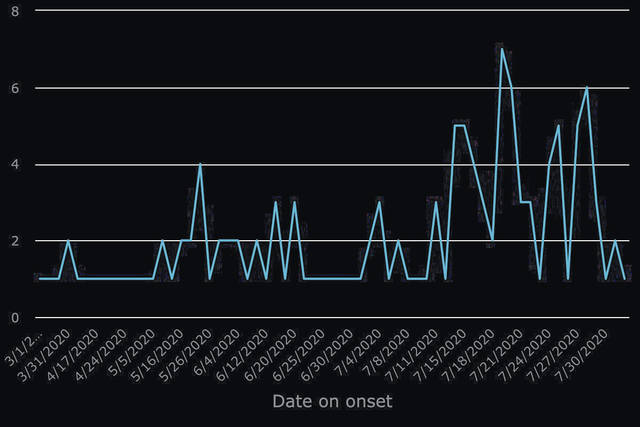
Highland County has had a total of 139 lab-confirmed and probable COVID-19 cases — 19 of which resulted in hospitalization and one of which resulted in death as of Monday, according to the Highland County Health Department.
In a Facebook post, the health department stated that probable cases “includes clinical presentation, epidemiological link, or FDA-approved antigen/antibody test.” There have been 10 such cases documented in Highland County since the pandemic began.
As of Monday, 31 people were actively sick, and the health department was monitoring 108 people for symptoms of COVID-19.
Since the beginning of the pandemic, 107 patients have recovered, the health department reported.
According to the ODH, of the cases in Highland County as of Tuesday:
* 26 cases involved 40- to 49-year-olds, two of whom were hospitalized.
* 25 cases involved 60- to 69-year-olds, three of whom were hospitalized.
* 22 cases involved 70- to 79-year-olds, six of whom were hospitalized.
* 21 cases involved 50- to 59-year-olds, two of whom were hospitalized.
* 19 cases involved 20- to 29-year-olds, one of whom was hospitalized.
* 12 cases involved 0- to 19-year-olds, one of whom was hospitalized.
* 9 cases involved 30- to 39-year-olds, one of whom was hospitalized.
* 2 cases involved someone 80 years old or older, both of whom were hospitalized and one of whom later died.
According to the Ohio Department of Health (ODH)’s public health advisory system, as of July 30, Highland County remains at a level 2 public emergency, which represents increased COVID-19 exposure and spread.
As of July 30, ODH indicated that the county has met two risk indicators: an increase in new cases per capita in the last two weeks, or “Indicator 1,” and the number of cases in a non-congregate setting.
On July 16, the ODH upgraded Highland County to a level 2 public emergency after the county met two risk indicators: the proportion of cases in a non-congregate setting and the percentage of occupied ICU beds.
In regard to the proportion of cases in a non-congregate setting, listed as “Indicator 3” on the ODH website, Highland County Health Commissioner Jared Warner wrote, “This indicator is flagged if the proportion of cases that are not in a congregate setting goes over 50 percent in at least one of the last 3 weeks. Used as an indicator of greater risk of community spread.”
In regard to the percentage of occupied ICU beds, listed as “Indicator 7” on the ODH website, Warner wrote, “The SW Ohio Region is above 80 percent ICU capacity. This indicator is flagged if the percentage of the occupied ICU beds in each region goes above 80 percent for at least three days in the last week. Provides an indication of the capacity available to manage a possible surge of severely ill patients.”
Other risk indicators include the number of new cases per capita; a sustained increase in new cases; a sustained increase in emergency room visits, where patients exhibit a COVID-like illness or are diagnosed with COVID-19; a sustained increase in outpatient visits involving patients with COVID-like symptoms who then receive a confirmed or suspected diagnosis; and a sustained increase in new COVID-19 hospital admissions.
For more information about these indicators, visit coronavirus.ohio.gov/wps/portal/gov/covid-19/public-health-advisory-system/.
In a previous interview, Warner expressed concern for a potential increase in the number of hospitalizations in the county.
“Everyone wants to focus on the fatality rate — that’s where they want to end the conversation. People keep forgetting the hospitalization rates that tend to be associated with this,” Warner said. “When we look at a population like Highland County that, as far as we can tell, is pretty sheltered from feeling the effects of this virus, there are a lot of people who could potentially get sick.”
According to Warner, about 12 to 14 percent of confirmed COVID-19 cases result in hospitalization, which can overwhelm health care systems as providers continue to receive patients with non-COVID-related health issues as well.
“I’ve seen graphs all over Facebook too that say, ‘This is how many people live in Ohio, and this is the number of people who have been impacted — why are they making such a big deal about it?’ Part of the reason we’re making a big deal is that most of the people who have not been impacted have also not been exposed,” Warner said. “They have no immunity, and we have very little treatment available to us. There’s really no prevention — no vaccine or anything like that. We have to take it seriously because we know it has a higher hospitalization rate. It’s also nine to ten times more deadly than the flu. It’s not something to panic about, but it does require a little bit of a different approach from a public health perspective.”
For more information visit coronavirus.ohio.gov.
Reach McKenzie Caldwell at 937-402-2570.


